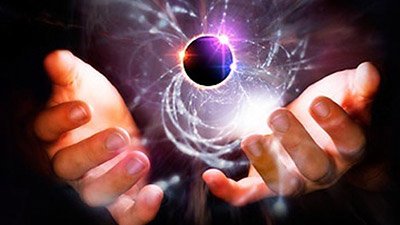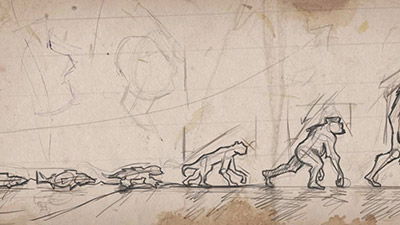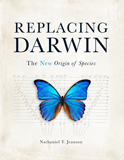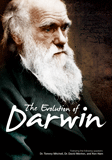Evolution
What is “evolution,” and how does it relate to creation? Discover how evolution supposedly works, its history, myths, and effect on Christian theology.
From Check This Out
Biological evolution is the supposed process by which the first cell evolved into the diversity of life we see today. Natural selection and mutations are considered its driving force; however, evolution has never been observed despite numerous protestations to the contrary. Natural selection and mutations cannot add the information necessary to change one kind of organism into another. And it doesn’t take a science degree to understand why molecules-to-man evolution is impossible.
Contents
- Evolution Defined: “Macro vs. Micro” Evolution
- History of Evolution: Charles Darwin and Others
- Evolutionary Thought Since Darwin
- The Genetic Challenge to Classic Darwinian Evolution
- How Mutations Work in Real Life
- The Origin of Life in Darwinian Evolution
- The Fossil Record Problem for Evolution
- Evolution’s Effects on Christian Theology
- Evolution and the Flood
- Evolution Requires Faith
- Myths About Evolution
- Life-Changing Answers for Evolutionists
Evolution Defined: “Macro vs. Micro” Evolution
Evolution is a word that is used a lot but is poorly defined. Evolutionists themselves frequently equivocate on the term, using it to mean multiple things, sometimes even within the same sentence.
“Macroevolution” is used to describe the large-scale changes believed to be able to turn a blob of protoplasm into a person. By contrast, “microevolution” is intended to describe the small-scale changes in populations, such as those exhibited by Darwin’s finches—the finch populations change beak sizes regularly in response to environmental pressures. However, they remain finches. No new traits or major changes take place.
Since the term evolution is so strongly associated with the particles-to-people myth, we tend to use the word speciation to explain adaptation and variation within the created kinds, such as that exhibited by the finches.Because the small-scale changes generally lead to a loss of genetic information rather than a gain of new information needed to create new traits like arms and eyes, microevolution can never lead to macroevolution. Evolutionists tend to use these ideas interchangeably. For this reason, we avoid those terms, preferring to speak of speciation within created kinds (which we can observe and verify) and molecules-to-man evolution (which is unobservable and unverifiable).

History of Evolution: Charles Darwin and Others
Many people believe that evolution began with Charles Darwin in 1859. This belief, however, is inaccurate. Evolution as an idea has existed since at least the Greek philosophers. A Frenchman named Jean-Baptiste Lamarck had proposed a form of evolution in the early 1800s. In fact, Darwin’s grandfather, Erasmus Darwin, engraved a Latin motto on his coach and book plates meaning “Everything from Shells,” indicating his belief in evolution.
Darwin built on past ideas and added his own wrinkle, one he borrowed from creationist Edward Blyth. Darwin observed that farmers could breed all manner of animal varieties using artificial selection. He then extrapolated from this that, given the millions of years his friend Charles Lyell proposed, whole new types of organisms could evolve “naturally” using Blyth’s process, hence natural selection. What Blyth saw as a conservative force in God’s creation meant to keep populations from breaking down, Darwin turned into a creative force that turned organisms into entirely new kinds of organisms over eons of time.
When Darwin published his famous book, the ground had already been prepared for its acceptance, particularly within the church. The scientific community, by and large, had accepted the millions-of-years hypothesis of Lyell and James Hutton, and these ideas, sadly, had seeped into the church. Numerous leading theologians of the day, such as Thomas Chalmers, were advocates of the Gap Theory, which attempted to add millions of years into the Bible. The influence of Chalmers and others like him caused many in the church to unquestioningly accept millions of years and some to even add Darwin’s evolutionary ideas into the Bible.
Evolutionary Thought Since Darwin
Since Darwin’s time, evolution has become the dominant dogma in the sciences, even in seemingly unrelated areas. It is impossible to go to a secular school and not get overdosed with evolutionary teaching. The base model of the dogma has changed very little since Darwin.
Evolutionists still teach that man evolved from apelike creatures over millions of years. Other aspects of the idea have been filled in so that the evolutionary skeleton looks a little more complete, at least for public consumption. However, digging beneath the surface reveals things are not well in the evolutionary dogma.
Evolution became permanently immortalized in American culture in 1925 in what was termed the “Scopes Monkey Trial” in Tennessee. Attempting to challenge a Tennessee state law that forbade teaching human evolution, the ACLU prompted a substitute teacher named John Scopes to admit to breaking the law, even though he later acknowledged he had never done so. The trial took on monumental proportions when two of the most famous lawyers in America, Clarence Darrow and William Jennings Bryan, took opposite positions. The trial ended with Scopes being convicted, but not before Darrow tricked Bryan into testifying and used him as a pincushion to mock the Bible.
The trial was later immortalized in a Hollywood move entitled Inherit the Wind, which got almost every basic fact about the case wrong and painted biblical creationists in the worst light possible. Tennessee’s law was eventually repealed, and Darwin’s ideas are now dominant in the public school system across the nation.

The Genetic Challenge to Classic Darwinian Evolution
Darwin had no knowledge of genetics, even though Mendel’s groundbreaking work on genetics was published during his lifetime. When genetics made its way into mainstream science, evolutionists adapted Darwin’s ideas to fit the emerging study of genetics, forming what is called the Modern Synthesis of Darwinian evolution, or neo-Darwinism. Most evolutionists today are adherents of neo-Darwinism to one extent or another. Neo-Darwinism emphasizes four major forces: gene flow, genetic drift, natural selection, and mutations. From these four forces, neo-Darwinists believe that they can explain the diversity of life on earth.
Natural selection is the primary mover in the evolutionary dogma. Natural selection allows organisms that are best suited to their environment to survive and pass on their genetics with greater frequency. These organisms, because they are best suited for their environment, produce the most offspring. Over time, the traits of these organisms become dominant in a population. This is where mutations come in.
Evolutionists regard mutations as the force that creates new variation. While they acknowledge that mutations almost always remove genetic potential, they believe that on rare occasions a mutation will occur that can create an entirely new trait that is beneficial in a certain environment. Natural selection will then increase this trait in a population. Given enough time, and enough beneficial mutations, neo-Darwinists believe that one kind of organism can turn into another kind of organism—a fish can become a philosopher.
How Mutations Work in Real Life
But the observable facts do not fit evolutionists’ dogma. Natural selection does happen, but it works just as Blyth envisioned it did: as a preservative, weeding out the worst mutations to preserve the health of a population. Scientists acknowledge natural selection is not the same as evolution. Mutations likewise occur, but most if not all mutations described as beneficial are only beneficial in certain, often unusual, situations.
Antibiotic resistant bacteria is an often-cited example of evolution in action by means of mutation and natural selection. Antibiotic resistance already existed in bacterial populations before they were exposed to antibiotics. When artificial selection was applied in the form of antibiotics, the resistant ones survived. However, if there is no antibiotic present, resistant bacteria represent a tiny percentage of the population. This is because the way they avoid the antibiotic also results in them having a much harder time intaking nutrients. The mutation is only advantageous in a very specific circumstance, yet detrimental in a normal environment. God even created bacteria “after their kind” so they will always be bacteria.
No Increase in Genetic Information
There is no known observable process by which new genetic information can be added to an organism’s genetic code, let alone how that information could arise from random chemicals in the first place. Information requires an intelligent source, since it requires not only data but also the ability to decode that data. This alone is enough to refute evolution because there’s no way for a fish to become an amphibian without new information.

The Origin of Life in Darwinian Evolution
Any ideas about how life could have started on earth overlook one important rule in biology: life doesn’t, cannot, and will never come from non-life. Life always comes from life. That’s the law—the law of biogenesis, to be exact. Scientists who try to simulate the origin of life really show how much intelligence is required for life to begin in the first place.
While Darwin himself never addressed the origin of the universe and rarely touched on the origin of life, both are key aspects of evolutionary dogma. While many evolutionists attempt to distance themselves from these, particularly the origin-of-life question, both are fundamentally necessary for evolution to be true. Since most evolutionists insist on a naturalistic explanation for everything, the origin of life and origin of the universe are both fundamental questions evolutionists must answer to support their dogma and a naturalistic worldview.
The origin-of-life question has troubled evolutionists for decades. In Darwin’s day, the internal workings of the cell were completely unknown. It was easy to speculate about the origin of something regarded simply as a tiny bag of slime. However, as we learned more about the intiricate workings of the cell, this became much more difficult.
In the 1950s, a famous experiment at the University of Chicago known as the Miller-Urey experiment attempted to demonstrate the naturalistic origin of life. In the textbooks and headlines, they are said to have created the building blocks of life in a test tube. What they actually created was a toxic soup that included amino acids, which had to be removed from the reaction chamber before they were destroyed in a second pass. The experiment also deliberately excluded oxygen, as it would have destroyed their results. This experiment is still cited today as evidence of life from non-life, likely because all attempts to improve on the experiment have failed to produce even the basic structures needed for life.
The Fossil-Record Problem for Evolution
The fossil record is regularly trotted out as containing the finest examples of evolutionary changes in organisms. Yet within the evolutionist community itself, there was a massive schism in the 1970s when the late Stephen Jay Gould and Niles Eldredge proposed the idea of punctuated equilibrium. This idea acknowledged a virtual absence of transitional forms in the fossil record and proposed that evolution was not a gradual process. Instead, it was a jerky, jumpy process that mostly involved stasis before great leaps of change. While less common today with the influence of the dynamic Gould removed, the mere fact that this idea gained popularity attests to the lack of transitional forms in the fossil record.
Evolutionists prop up their dogma by claiming the earth is millions or even billions of years old. The most common proof of these great ages is radiometric dating. It is not carbon-14 dating, despite Hollywood being fixated on this dating method. Carbon-14 dating would only work on carbon-containing materials that are “only” a few tens of thousands of years old. Yet carbon-14 has been found in diamonds, which are supposedly billions of years old. It should be long gone, but it isn’t.
Other forms of radiometric dating include uranium-lead dating, potassium-argon dating, rubidium-strontium dating and so on. All are governed by three basic assumptions. Scientists assume they know how much of both the parent and daughter element existed in the rock when it was formed. They assume that none of either the parent or daughter element was added or lost during the decay process.
Finally, they assume that the rate of decay has been constant. None of these assumptions can be empirically proven. In fact, creationists have done radiometric testing on rocks of known ages, such as those formed in the Mount St. Helens eruption, and found that they dated at tens of thousands of years old despite being formed in 1980. Radiometric dating does not work as a reliable indicator of the age of the earth or its rocks.
Very little of what evolutionists present as evidence for their dogma is good science. In fact, the mere idea of naturalistic evolution is anti-science. If evolution were true and if a random chance process created the world, then that same process of chance created the human brain and its powers of logic. If the brain and its use of logic came about by chance, why trust its conclusions? To be consistent, evolutionists should reject their own ability to reason logically. Of course if they did that, they would have to reject their own dogma as well, compelling them to accept a creator. Evolution is a self-refuting religion.
The types of changes evolution requires would be expected to provide many examples of missing links in virtually every layer of the geologic record. This is not the case. The geologic record is better explained by the global flood and the subsequent localized catastrophes after the flood.

Evolution’s Effects on Christian Theology
Unfortunately, as in Darwin’s day, much of the church has accepted millions of years and evolution as fact, without ever considering the underlying assumptions or how the acceptance of these assumptions undermines the biblical text and the gospel.
For example, consider what happens when you attempt to add evolution into the Bible. Adam and Eve are no longer the first humans, and original sin goes out the window. This does irreparable damage to the biblical redemption narrative. The Bible says that death came into the world because of man’s sin (Romans 5:12) and that all of creation labors under a curse because of sin (Romans 8:22). Scripture also says that Christ is the last Adam, come to redeem us from the sin brought into the world through the first man, Adam (1 Corinthians 15:22, 45). If Adam were a mythical figure, which is what evolution demands, even in a Christianized form, the entire parallel between the two Adams and the kinsman redeemer concept is destroyed. By advocating evolution, theistic evolutionists are undermining the very tenets of Christianity.
Those Christians who reject evolution but accept millions of years have an equivalent problem. Jesus, when explaining marriage to the Sadducees, referred to Adam and Eve as existing from the beginning of creation (Mark 10:6). According to those who accept millions of years, Adam and Eve only existed after billions and millions of years of death: this makes Jesus either ignorant or a liar. Further, when God finished his creation he called everything very good (Genesis 1:31). In order for the millions of years to be true, God would have to be calling the fossil record, which records disease, death, violence, and suffering, very good. That is inconsistent with the character of God revealed throughout the rest of Scripture.
God tells us in Genesis exactly how he created the world, and even the order of events doesn’t match the evolutionary tale. In addition, one of the things that drives evolution is death. But the Bible teaches that death was introduced into the perfect world as a result of Adam’s sin. When Christians try to reinterpret God’s infallible Word based on the ideas of fallible men, it undermines the gospel of Jesus Christ.

Evolution and the Flood
Further, attempting to combine evolution or millions of years with the biblical text forces Christians to reject the reality of the global flood of Noah’s day. If the fossil record was laid down before man, then the flood is not necessary to bury the fossils and, in fact, conflicts with the existing record. Therefore, according to these individuals, the flood had to be local or mythical. This raises all manner of questions such as; why did God not just tell Noah to move or how did a local flood cover all the mountains and yet remain local? The only way to get around these questions is to torture the Hebrew text and the concept of biblical inerrancy.
Evolution, whether couched in Christianized language or presented in its natural atheistic colors, remains an utterly bankrupt and failed hypothesis about the origin of the universe or the diversity of life on earth. In no instance has cosmological, geological, or biological evolution been demonstrated, and the most common evidences for evolution all have been debunked. Attempting to add evolution to Christianity is both unbiblical and irrational, since evolution itself is not science but anti-science. Neither the Bible nor empirical science support its claims.
Evolution Requires Faith
For many, a belief in evolution comes from the desire to remove the need for God as Creator. Some would say evolution comes from what the evidence says to us. But evidence never speaks for itself, it’s always interpreted using your assumptions and starting points. And only when you examine the evidence through the lens of the Bible does it makes sense.
Evolution is rooted in the belief system of naturalism that doesn’t allow for anything outside the laws of nature to explain how our world operates. Ironically, naturalism requires the violation of several known laws of the universe.
- The law of biogenesis (life only comes from life)
- The uniformity of nature (uniformity cannot exist or be expected without a creator)
- The laws of physics (the big bang requires the suspension of the laws of physics, nor could those laws exist without a creator)
- The laws of probability (the fine tuning of the universe requires a creator)
- The laws of logic (logic requires a logical source)
- The laws of chemistry (the consistent properties of the elements require intelligence)
- The laws of information (information can only come from an intelligence)
To accept that all of these things truly operate in the world without God as their Creator and Organizer requires an immense amount of faith. While it is often used as a criticism of Christians, those who have an evolutionary worldview must accept all of these things by blind faith since there is no naturalistic explanation for the existence of these laws. While Christians also accept certain truths by faith, it is faith in the Creator and Lawgiver who provides a basis for those truths, not a blind faith in blind, chance processes.
Myths About Evolution
-
“98% similarity” between human and chimp DNA
This difference actually represents millions of letters of difference and many differences are not represented in the “98% similarity.” This is actually strong evidence for a common Designer, who used common building blocks in his design but gave humanity characteristics unlike any other creature he made.
-
“Ape-men”
The pervasive ape-to-human montage and other "reconstructions" are just artwork based on imagination, wishful thinking, and presuppositional influence. All the supposed ape-men can be classified as either human or ape, not transitional forms.
-
Bad Design
Some structures seem to show less-than-optimal design, and to some evolutionists this proves there is no creator. But a universe that has been cursed with degeneration for over 6,000 years won't maintain optimal design. The fact that we continue to survive is evidence of how good the original design was.
-
Vestigial Organs and Junk DNA
Evolutionists claim that humans and other animals have organs and DNA leftover from evolution. But these reports are often based on evolutionary expectations. The appendix, for example, was once thought vestigial, but now we know its function. Even a true loss of function shows a world that is in decay, which is exactly what the Bible says.
-
All Scientists Agree
Even if every single person accepted an idea, that doesn’t make the idea correct. Many embrace evolution because they won’t allow for anything miraculous or supernatural. But there are a growing number of scientists, creationist and not, who do not find the supposed evidence for evolution to be valid or convincing.
-
Similarities Show Past Evolutionary Connections
Similarities in anatomy supposedly prove descent from a common ancestor. But structures that appear similar (homologous) often develop under the control of genes that are not homologous. There is another logical reason why things look alike—creation by an intelligent designer using a common blueprint.
Life-Changing Answers for Evolutionists
There are numerous anatomical structures that are clearly designed. Many are irreducibly complex, meaning the parts serve no benefit unless they all exist and are working together. There are many such examples of design in biology. All of these point to an intelligent Creator and Designer.
So we’re left with an inescapable conclusion: there must be a powerful and super-wise Creator. With such a Creator, you no longer need billions of years. He could create everything in much less time—say . . . six days. This Creator gave us a clear record (the Bible) of how he created the world, how long it took him, how humans fell into sin, and how God the Son (Jesus) came to earth to save us from our sinful rebellion against him.
Since we can trust the Bible’s history and science, we can also trust what it says about Jesus Christ, God’s Son, and why he came. Keep reading to find more answers!
Evolution Topics
-
Big Bang
Does observational science support the big bang, the idea that 13 billion years ago all matter came from nothing and eventually formed everything we see today?
-
Charles Darwin
Charles Darwin, famed author of Origin of Species, is remembered as the man who popularized evolution. Have the last 200 years of research proved his ideas?
-
Evidence Against Evolution
Contrary to the popular cry that “science has proven evolution as fact,” the scientific facts themselves argue against evolution.
-
Human Evolution
Are humans simply the by-product of evolution from an ape-like ancestor or were they lovingly fashioned by God in His own image?
-
Missing Links
Do transitional forms really exist between microbe and microbiologist, or are they missing links? In the biblical worldview, they never existed at all!
-
Natural Selection
Is natural selection, which uses existing information leading to varations in organisms, proof of information-adding, molecules-to-man evolution?
-
Origin of Life
Big bangs and stardust, primordial soup, meteorites with amino acids, or maybe aliens seeded life on earth? A Creator God is a much more logical choice.
-
Scopes Trial
Trial of the century! Bryan cannot defend Scripture due to old-earth compromises. Evolution in schools loses the court battle but wins the classrooms.
-
Theistic Evolution
Theistic evolution, the idea that God used evolution to create life, poses great danger to the gospel, the Bible’s authority, and the character of the Creator.
-
Theory of Evolution
Biological evolution: is it a scientific fact, a theory, or just a hypothesis? How does this model of origins hold up under careful scientific scrutiny?
-
Young-Earth Evolution
Subtle ideas that don’t comport with Scripture or are unnecessarily accommodating of evolutionary ideas are causing problems within the church.
News About Evolution
-
Sept. 23, 2023 from Ken Ham Blog
Fossilization, especially of something as fragile as a small trail in the mud, is a rare process requiring very specific conditions, particularly a quick burial.
Articles About Evolution
-
Jan. 13, 2024 from Answers in Depth
Phylogenetics, the proposed evolutionary history of a species (or group of species), ultimately fails because of flawed scientific and philosophical assumptions.
-
Nov. 5, 2023 from Answers Magazine
Prominent scientists are speaking out against Darwinian evolution, and they’re not even creationists.
Recommended Resources

Answers in Genesis is an apologetics ministry, dedicated to helping Christians defend their faith and proclaim the good news of Jesus Christ.
- Customer Service 800.778.3390
- © 2024 Answers in Genesis




















